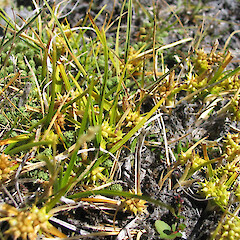Carex flaviformis
Common name
yellow sedge
Synonyms
None
Family
Cyperaceae
Flora category
Vascular – Native
Endemic taxon
No
Endemic genus
No
Endemic family
No
Structural class
Sedges
NVS code
The National Vegetation Survey (NVS) Databank is a physical archive and electronic databank containing records of over 94,000 vegetation survey plots - including data from over 19,000 permanent plots. NVS maintains a standard set of species code abbreviations that correspond to standard scientific plant names from the Ngä Tipu o Aotearoa - New Zealand Plants database.
CARFLA
Chromosome number
2n = c.64
Current conservation status
The conservation status of all known New Zealand vascular plant taxa at the rank of species and below were reassessed in 2017 using the New Zealand Threat Classification System (NZTCS) – more information about this can be found on the NZTCS website. This report includes a statistical summary and brief notes on changes since 2012 and replaces all previous NZTCS lists for vascular plants.
Please note, threat classifications are often suggested by authors when publications fall between NZTCS assessment periods – an interim threat classification status has not been assessed by the NZTCS panel.
- Conservation status of New Zealand indigenous vascular plants, 2017 . 2018. Peter J. de Lange, Jeremy R. Rolfe, John W. Barkla, Shannel P. Courtney, Paul D. Champion, Leon R. Perrie, Sarah M. Beadel, Kerry A. Ford, Ilse Breitwieser, Ines Schönberger, Rowan Hindmarsh-Walls, Peter B. Heenan and Kate Ladley. Department of Conservation. Source: NZTCS and licensed by DOC for reuse under the Creative Commons Attribution 4.0 International licence.
2017 | Not Threatened
Previous conservation statuses
2012 | Not Threatened
2009 | Not Threatened
2004 | Not Threatened
Distribution
Indigenous. New Zealand: North (Cape Palliser), South, Stewart and Chatham Islands. Also in Tasmania
Habitat
Coastal to alpine (up to 1400 m a.s.l.). In the northern part of its South Island range it is usually found well inland. However in the North and Chatham Islands, and in parts of its range on Stewart Island it is mostly found in permanently damp coastal and lowland turfs often bordering slowly flowing streams and wetlands.
Wetland plant indicator status rating
Information derived from the revised national wetland plant list prepared to assist councils in delineating and monitoring wetlands (Clarkson et al., 2021 Manaaki Whenua – Landcare Research Contract Report LC3975 for Hawke’s Bay Regional Council). The national plant list categorises plants by the extent to which they are found in wetlands and not ‘drylands’. The indicator status ratings are OBL (obligate wetland), FACW (facultative wetland), FAC (facultative), FACU (facultative upland), and UPL (obligate upland). If you have suggestions for the Wetland Indicator Status Rating, please contact: [Enable JavaScript to view protected content]
OBL: Obligate Wetland
Almost always is a hydrophyte, rarely in uplands (non-wetlands).
Detailed description
Yellow-green to yellow, rather stiffly tufted sedge. Culms 50–300 × 1.0–1.5 mm, smooth, trigonous, lower half usually ensheathed by leaves; basal bracts cream to dark grey, rarely reddish. Leaves much > culms, 2–3 mm. wide, initially double-folded but maturing almost flat, margins and keel scabrid towards the tip with small, close-set teeth. Inflorescence of 3–8 yellow-green, sessile, densely crowded spikes forming a head up to 30 mm long and up to 25 mm diameter, occasionally all spikes androgynous, or terminal spike male, 10–20 mm × 1.5–2.0 mm, lateral spikes female or androgynous, upper more often androgynous, lower more often female, 6–15 × 6–8 mm.; bracts subtending inflorescence leaf-like, often overtopping the foliage leaves. Glumes much < utricles, oblong-ovate, obtuse, membranous, white, sometimes tinged with brown, the centre green, with white midrib not usually excurrent. Utricles 3.5–4.5 × c. 1.5 mm., inflated or subtrigonous, ovoid, rather bright yellow-green, spreading when mature, nerves well-marked; beak 1.0–1.5 mm long, very narrow, green, papillose, shortly bifid with scabrid orifice or almost entire; stipe minute or absent. Stigmas 3. Nut c. 1.5 mm long, trigonous with thickened angles, especially near centre of nut, obovoid, light yellow-brown.
Similar taxa
The yellow-green to yellow leaves and yellow-green utricles immediately distinguish Carex flaviformis from all but the naturalised C. demissa Hornem. Carex demissa differs from C. flaviformis by the male spike which is shortly pedunculate rather than sessile; and by the female spikes which are not very closely clustered (rather than closely clustered) at the base of the male spike, typically with lowest rather distant.
Flowering
October–January
Fruiting
December–June
Life cycle
Nuts surrounded by inflated utricles are dispersed by granivory and wind (Thorsen et al., 2009).
Propagation technique
Easily grown from fresh seed and by division of established plants. Tolerant of a wide range of conditions but prefers full sun and permanently damp substrate. The yellowish foliage is rather attractive.
Etymology
carex: Latin name for a species of sedge, now applied to the whole group.
flaviformis: Like a European yellow sedge
Attribution
Fact Sheet prepared by P.J. de Lange (10 August 2006). Description adapted from Moore and Edgar (1970)
References and further reading
Moore LB, Edgar E. 1970. Flora of New Zealand, Volume II. Indigenous Tracheophyta: Monocotyledones except Gramineae. Government Printer, Wellington, NZ. 354 p.
Thorsen MJ, Dickinson KJM, Seddon PJ. 2009. Seed dispersal systems in the New Zealand flora. Perspectives in Plant Ecology, Evolution and Systematics 11: 285–309.
NZPCN Fact Sheet citation
Please cite as: de Lange, P.J. (Year at time of access): Carex flaviformis Fact Sheet (content continuously updated). New Zealand Plant Conservation Network. https://www.nzpcn.org.nz/flora/species/carex-flaviformis/ (Date website was queried)












